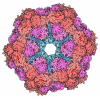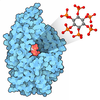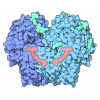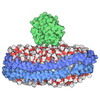+ Open data
Open data
- Basic information
Basic information
| Entry | Database: PDB / ID: 8s9p | ||||||
|---|---|---|---|---|---|---|---|
| Title | 1:1:1 agrin/LRP4/MuSK complex | ||||||
 Components Components |
| ||||||
 Keywords Keywords | SIGNALING PROTEIN / agrin / LRP4 / MuSK / NMJ / RTK | ||||||
| Function / homology |  Function and homology information Function and homology informationpositive regulation of presynaptic membrane organization / positive regulation of protein geranylgeranylation / Defective B3GALT6 causes EDSP2 and SEMDJL1 / Defective B4GALT7 causes EDS, progeroid type / Defective B3GAT3 causes JDSSDHD / Defective EXT2 causes exostoses 2 / Defective EXT1 causes exostoses 1, TRPS2 and CHDS / positive regulation of synaptic assembly at neuromuscular junction / regulation of synaptic assembly at neuromuscular junction / clustering of voltage-gated sodium channels ...positive regulation of presynaptic membrane organization / positive regulation of protein geranylgeranylation / Defective B3GALT6 causes EDSP2 and SEMDJL1 / Defective B4GALT7 causes EDS, progeroid type / Defective B3GAT3 causes JDSSDHD / Defective EXT2 causes exostoses 2 / Defective EXT1 causes exostoses 1, TRPS2 and CHDS / positive regulation of synaptic assembly at neuromuscular junction / regulation of synaptic assembly at neuromuscular junction / clustering of voltage-gated sodium channels / synaptic assembly at neuromuscular junction / chondroitin sulfate binding / skeletal muscle acetylcholine-gated channel clustering / Glycosaminoglycan-protein linkage region biosynthesis / HS-GAG biosynthesis / postsynaptic membrane assembly / presynaptic membrane assembly / HS-GAG degradation / sialic acid binding / negative regulation of axonogenesis / proximal/distal pattern formation / Wnt-protein binding / dystroglycan binding / amyloid-beta clearance by cellular catabolic process / positive regulation of skeletal muscle acetylcholine-gated channel clustering / Formation of the dystrophin-glycoprotein complex (DGC) / NCAM1 interactions / heparan sulfate proteoglycan binding / dorsal/ventral pattern formation / negative regulation of ossification / limb development / positive regulation of filopodium assembly / embryonic digit morphogenesis / dendrite morphogenesis / generation of neurons / enzyme-linked receptor protein signaling pathway / neuromuscular junction development / receptor clustering / RSV-host interactions / odontogenesis of dentin-containing tooth / positive regulation of Rac protein signal transduction / Respiratory syncytial virus (RSV) attachment and entry / basement membrane / Non-integrin membrane-ECM interactions / apolipoprotein binding / regulation of postsynapse assembly / plasma membrane raft / positive regulation of GTPase activity / hair follicle development / ECM proteoglycans / Integrin cell surface interactions / Retinoid metabolism and transport / coreceptor activity / laminin binding / transmembrane receptor protein tyrosine kinase activity / lysosomal lumen / cell surface receptor protein tyrosine kinase signaling pathway / synaptic membrane / neuromuscular junction / kidney development / negative regulation of canonical Wnt signaling pathway / receptor protein-tyrosine kinase / receptor tyrosine kinase binding / synapse organization / structural constituent of cytoskeleton / Golgi lumen / memory / Wnt signaling pathway / positive regulation of protein phosphorylation / endocytosis / G protein-coupled acetylcholine receptor signaling pathway / : / protein autophosphorylation / protein tyrosine kinase activity / scaffold protein binding / postsynaptic membrane / Attachment and Entry / cell differentiation / receptor complex / postsynaptic density / neuronal cell body / calcium ion binding / synapse / dendrite / positive regulation of gene expression / cell surface / signal transduction / protein homodimerization activity / positive regulation of transcription by RNA polymerase II / extracellular exosome / extracellular region / ATP binding / metal ion binding / plasma membrane Similarity search - Function | ||||||
| Biological species |  Homo sapiens (human) Homo sapiens (human) | ||||||
| Method | ELECTRON MICROSCOPY / single particle reconstruction / cryo EM / Resolution: 3.8 Å | ||||||
 Authors Authors | Xie, T. / Xu, G.J. / Liu, Y. / Quade, B. / Lin, W.C. / Bai, X.C. | ||||||
| Funding support |  United States, 1items United States, 1items
| ||||||
 Citation Citation |  Journal: Proc Natl Acad Sci U S A / Year: 2023 Journal: Proc Natl Acad Sci U S A / Year: 2023Title: Structural insights into the assembly of the agrin/LRP4/MuSK signaling complex. Authors: Tian Xie / Guangjun Xu / Yun Liu / Bradley Quade / Weichun Lin / Xiao-Chen Bai /  Abstract: MuSK is a receptor tyrosine kinase (RTK) that plays essential roles in the formation and maintenance of the neuromuscular junction. Distinct from most members of RTK family, MuSK activation requires ...MuSK is a receptor tyrosine kinase (RTK) that plays essential roles in the formation and maintenance of the neuromuscular junction. Distinct from most members of RTK family, MuSK activation requires not only its cognate ligand agrin but also its coreceptors LRP4. However, how agrin and LRP4 coactivate MuSK remains unclear. Here, we report the cryo-EM structure of the extracellular ternary complex of agrin/LRP4/MuSK in a stoichiometry of 1:1:1. This structure reveals that arc-shaped LRP4 simultaneously recruits both agrin and MuSK to its central cavity, thereby promoting a direct interaction between agrin and MuSK. Our cryo-EM analyses therefore uncover the assembly mechanism of agrin/LRP4/MuSK signaling complex and reveal how MuSK receptor is activated by concurrent binding of agrin and LRP4. | ||||||
| History |
|
- Structure visualization
Structure visualization
| Structure viewer | Molecule:  Molmil Molmil Jmol/JSmol Jmol/JSmol |
|---|
- Downloads & links
Downloads & links
- Download
Download
| PDBx/mmCIF format |  8s9p.cif.gz 8s9p.cif.gz | 291.4 KB | Display |  PDBx/mmCIF format PDBx/mmCIF format |
|---|---|---|---|---|
| PDB format |  pdb8s9p.ent.gz pdb8s9p.ent.gz | 188.3 KB | Display |  PDB format PDB format |
| PDBx/mmJSON format |  8s9p.json.gz 8s9p.json.gz | Tree view |  PDBx/mmJSON format PDBx/mmJSON format | |
| Others |  Other downloads Other downloads |
-Validation report
| Summary document |  8s9p_validation.pdf.gz 8s9p_validation.pdf.gz | 1.2 MB | Display |  wwPDB validaton report wwPDB validaton report |
|---|---|---|---|---|
| Full document |  8s9p_full_validation.pdf.gz 8s9p_full_validation.pdf.gz | 1.3 MB | Display | |
| Data in XML |  8s9p_validation.xml.gz 8s9p_validation.xml.gz | 45.7 KB | Display | |
| Data in CIF |  8s9p_validation.cif.gz 8s9p_validation.cif.gz | 66 KB | Display | |
| Arichive directory |  https://data.pdbj.org/pub/pdb/validation_reports/s9/8s9p https://data.pdbj.org/pub/pdb/validation_reports/s9/8s9p ftp://data.pdbj.org/pub/pdb/validation_reports/s9/8s9p ftp://data.pdbj.org/pub/pdb/validation_reports/s9/8s9p | HTTPS FTP |
-Related structure data
| Related structure data |  40241MC M: map data used to model this data C: citing same article ( |
|---|---|
| Similar structure data | Similarity search - Function & homology  F&H Search F&H Search |
- Links
Links
- Assembly
Assembly
| Deposited unit | 
|
|---|---|
| 1 |
|
- Components
Components
| #1: Protein | Mass: 217553.922 Da / Num. of mol.: 1 Source method: isolated from a genetically manipulated source Source: (gene. exp.)  Homo sapiens (human) / Gene: AGRN, AGRIN / Production host: Homo sapiens (human) / Gene: AGRN, AGRIN / Production host:  Homo sapiens (human) / References: UniProt: O00468 Homo sapiens (human) / References: UniProt: O00468 |
|---|---|
| #2: Protein | Mass: 212287.031 Da / Num. of mol.: 1 Source method: isolated from a genetically manipulated source Source: (gene. exp.)  Homo sapiens (human) / Gene: LRP4, KIAA0816, LRP10, MEGF7 / Production host: Homo sapiens (human) / Gene: LRP4, KIAA0816, LRP10, MEGF7 / Production host:  Homo sapiens (human) / References: UniProt: O75096 Homo sapiens (human) / References: UniProt: O75096 |
| #3: Protein | Mass: 97163.227 Da / Num. of mol.: 1 Source method: isolated from a genetically manipulated source Source: (gene. exp.)  Homo sapiens (human) / Gene: MUSK / Production host: Homo sapiens (human) / Gene: MUSK / Production host:  Homo sapiens (human) Homo sapiens (human)References: UniProt: O15146, receptor protein-tyrosine kinase |
| Has protein modification | Y |
-Experimental details
-Experiment
| Experiment | Method: ELECTRON MICROSCOPY |
|---|---|
| EM experiment | Aggregation state: PARTICLE / 3D reconstruction method: single particle reconstruction |
- Sample preparation
Sample preparation
| Component | Name: 1:1:1 agrin/LRP4/MuSK complex / Type: COMPLEX / Entity ID: all / Source: RECOMBINANT |
|---|---|
| Molecular weight | Experimental value: NO |
| Source (natural) | Organism:  Homo sapiens (human) Homo sapiens (human) |
| Source (recombinant) | Organism:  Homo sapiens (human) Homo sapiens (human) |
| Buffer solution | pH: 7.4 / Details: 25 mM HEPES pH 7.4, 150 mM NaCl, and 2 mM CaCl2 |
| Specimen | Conc.: 0.56 mg/ml / Embedding applied: NO / Shadowing applied: NO / Staining applied: NO / Vitrification applied: YES |
| Specimen support | Grid material: GOLD / Grid mesh size: 300 divisions/in. / Grid type: Quantifoil |
| Vitrification | Instrument: FEI VITROBOT MARK IV / Cryogen name: ETHANE / Humidity: 100 % |
- Electron microscopy imaging
Electron microscopy imaging
| Experimental equipment |  Model: Titan Krios / Image courtesy: FEI Company |
|---|---|
| Microscopy | Model: FEI TITAN KRIOS |
| Electron gun | Electron source:  FIELD EMISSION GUN / Accelerating voltage: 300 kV / Illumination mode: FLOOD BEAM FIELD EMISSION GUN / Accelerating voltage: 300 kV / Illumination mode: FLOOD BEAM |
| Electron lens | Mode: BRIGHT FIELD / Nominal defocus max: 2600 nm / Nominal defocus min: 1600 nm |
| Image recording | Electron dose: 60 e/Å2 / Film or detector model: GATAN K3 BIOQUANTUM (6k x 4k) |
| EM imaging optics | Energyfilter name: GIF Bioquantum / Energyfilter slit width: 20 eV |
- Processing
Processing
| EM software |
| ||||||||||||||||||||||||
|---|---|---|---|---|---|---|---|---|---|---|---|---|---|---|---|---|---|---|---|---|---|---|---|---|---|
| CTF correction | Type: PHASE FLIPPING AND AMPLITUDE CORRECTION | ||||||||||||||||||||||||
| Particle selection | Num. of particles selected: 2414116 | ||||||||||||||||||||||||
| 3D reconstruction | Resolution: 3.8 Å / Resolution method: FSC 0.143 CUT-OFF / Num. of particles: 82511 / Symmetry type: POINT |
 Movie
Movie Controller
Controller



 PDBj
PDBj






















